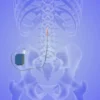Provided By: Mayo Clinic
Radiofrequency neurotomy uses heat generated by radio waves to target specific nerves and temporarily turn off their ability to send pain signals.
Needles inserted through the skin near the painful area deliver the radio waves to the targeted nerves. A health care provider will typically use imaging scans during radiofrequency neurotomy to make sure the needles are positioned properly.
Radiofrequency neurotomy is most commonly used for pain in the back, neck, and buttocks (sacroiliac joint). It may also be helpful for long-term shoulder, knee, or hip joint pain.
Why it’s done
Radiofrequency neurotomy is usually done by a provider who specializes in treating pain. The goal is to reduce chronic back, neck, hip, or knee pain that hasn’t improved with medications or physical therapy, or when surgery isn’t an option.
For example, your provider may suggest the procedure if you have back pain that:
- Occurs on one or both sides of your lower back
- Spreads to the buttocks and thighs (but not below the knee)
- Feels worse if you twist or lift something
- Feels better when you’re lying down
Radiofrequency neurotomy might also be recommended to treat neck pain associated with whiplash.
How you prepare
To determine if you’re a good candidate for radiofrequency neurotomy, your provider may refer you to a pain specialist or order more tests.
For example, a test may be done to see if the nerves commonly targeted by the procedure are the same nerves responsible for your pain. A small amount of numbing medication is injected into the precise spots where the radiofrequency needles will go. If your pain significantly lessens, radiofrequency treatment at those spots may help you.
However, the provider may determine that a different procedure is needed to help your specific symptoms.
What you can expect before radiofrequency neurotomy
Let your provider know if you take blood-thinning medications. You may need to stop taking them for a period of time before the procedure.
Follow these steps:
- Arrange for someone to drive you home.
- Swallow any necessary medications with clear liquids only and take them as early in the day as possible. Don’t take medications within two hours of your procedure.
- Don’t smoke or use any tobacco products on the day of your procedure.
During radiofrequency neurotomy
Radiofrequency neurotomy is an outpatient procedure, so you’ll go home later that same day.
You’ll wear a hospital gown and lie on your stomach on an X-ray table. An intravenous (IV) line will be placed in your arm or hand to deliver medication that will keep you comfortable during the procedure. Numbing medication will be injected into your skin before the radiofrequency needles are inserted.
The provider will then use a special X-ray machine (fluoroscope) to guide the radiofrequency needles to the precise area — so only the targeted nerve tissue will be treated.
After radiofrequency neurotomy
You’ll be taken to another room to rest until you feel ready to go home. You might notice some soreness in the area where the needles were inserted, but this usually goes away in a day or two.
When you get home:
- Use an ice pack on the injection sites if you have discomfort. Place the pack on the sore spot for 20 minutes, three or four times a day, during the first day of your recovery.
- Don’t use a heating pad on the injection sites.
- Avoid baths for two days. You may take a warm shower 24 hours after your procedure.
Results
Radiofrequency neurotomy isn’t a permanent fix for back or neck pain.
Studies on the success of treatment have been conflicting. Some people may have modest, short-term pain relief, while others might feel better for several months. Sometimes, the treatment does not improve pain or function at all.
For the treatment to work and for you to feel better, it’s important that the nerves targeted by the procedure are the same nerves responsible for your pain.
To learn more about how we can help with radiofrequency neurotomy, click here!





